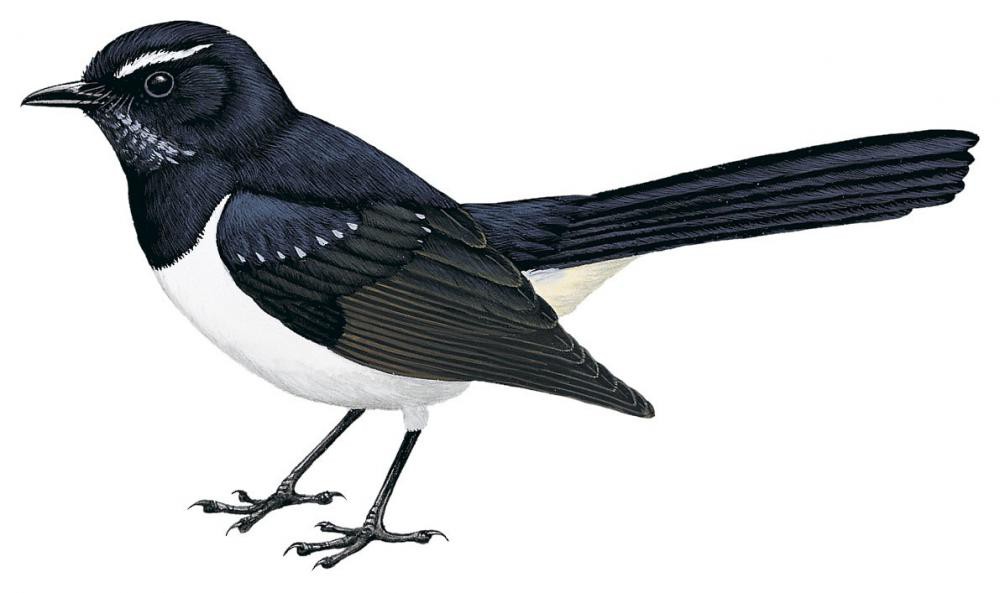Willie-wagtail / Rhipidura leucophrys

Willie-wagtail
SCI Name:
Protonym: Turdus leucophrys Suppl.ind.orn. p.xlv
Taxonomy: Passeriformes / Rhipiduridae / Rhipidura
Taxonomy Code: wilwag1
Type Locality: New Holland = Sydney, fide Mathews, 1930, Syst. Avium Australasianarum, p. 496.
Author: Latham
Publish Year: 1801
IUCN Status: Least Concern
DEFINITIONS
RHIPIDURA
(Rhipiduridae; Ϯ New Zealand Fantail R. fuliginosa) Gr. ῥιπις rhipis, ῥιπιδος rhipidos fan; ουρα oura tail; “Fan-tailed Fly-catcher ... flies always with its tail spread in shape of a fan.” (Latham 1783); "Genus. RHIPIDURA*. Rostrum breve, depressum, basi latum, apice compressum, culmine arcuato; mandibula superiore apice emarginata; naribus basalibus, ovalibus, setis plumulisque fere obtectis; rictu vibrissis confertis mandibulas longitudine fere superantibus instructo. Alæ mediocres, subacuminatæ; remige prima brevissima, secunda duplo longiore, tertia et quarta, quæ est longissima, gradatim longioribus. Cauda elongata, patula, apice rotundata. Pedes mediocres, graciles, acrotarsiis paratarsiisque integris. This group may be at once recognised as offering strong marks of distinction from the true Muscicapa in the fan-like structure of the tail. ... *'Pιπις flabellum, and ουρα cauda. ... 1. FLABELLIFERA. ... Muscicapa flabellifera. Gmel. i. 943. no. 67. Fan-tailed Flycatcher. Lath. Gen. Hist. vi. p. 184. no. 44. pl. 99. ... Fantail.—There is something singular in the habits of this bird. It frequents the small trees and bushes, from whence it suddenly darts at its prey, spreading out its tail like a fan, and to appearance turning over like a tumbler Pigeon, and then immediately returning to the same twig or bough from whence it sprang. ... 2. MOTACILLOIDES. ... It bears a great resemblance to the description of Dr. Latham's Motacilla atricapilla, or the Black-topped Flycatcher of his "General History," but differs in the colour of the bill, back and throat. ... 3. RUFIFRONS. ... Muscicapa rufifrons. Lath. Ind. Orn. Supp. p. 1. no. 5. Rufous-fronted Flycatcher. Id. Gen. Hist. vi. p. 213. no. 95." (Vigors & Horsfield 1827); "Rhipidura Vigors and Horsfield, 1827, Trans. Linn. Soc. London, 15, p. 246. Type, by subsequent designation (G. R. Gray, 1840, List Gen. Birds, p. 32), Muscicapa flabellifera Gmelin [= Muscicapa fuliginosa Sparrman]." (Mayr in Peters 1986, XI, 530).
Var. Ripidura, Rhipadura, Rhissidura.
Synon. Cyanonympha, Howeavis, Leucocirca, Muscylva, Neomyias, Rhipidicidura, Ripidicala, Rupicula, Sauloprocta, Setosura.
rhipidura / rhipidurus
Gr. ῥιπις rhipis, ῥιπιδος rhipidos fan; -ουρος -ouros -tailed < ουρα oura tail.
leucophrys
Gr. λευκοφρυς leukophrus, λευκοφρυος leukophruos white-browed < λευκος leukos white; οφρυς ophrus, οφρυος ophruos eyebrow.
● ex “Pato ceja blanca” of de Azara 1802-1805, no. 442 (Callonetta).
● ex “Grivetin” of Levaillant 1802, pl. 118 (Cercotrichas).
Leucophrys
(syn. Plocepasser Ϯ White-browed Sparrow Weaver P. mahali) Gr. λευκοφρυς leukophrus, λευκοφρυος leukophruos white-browed < λευκος leukos white; οφρυς ophrus, οφρυος ophruos eyebrow; "Leucophrys, Sw. Bill unequally conic; the sides not swollen; the tip entire. Nostrils naked, round ... L. pileatus. Part 5. No. 199" (Swainson 1837).
SUBSPECIES
Willie-wagtail (picata)
SCI Name: Rhipidura leucophrys picata
picata
L. picatus bedaubed with tar, pied < pix, picis pitch (cf. L. pica magpie (i.e. black and white)).
Willie-wagtail (leucophrys)
SCI Name: Rhipidura leucophrys leucophrys
leucophrys
Gr. λευκοφρυς leukophrus, λευκοφρυος leukophruos white-browed < λευκος leukos white; οφρυς ophrus, οφρυος ophruos eyebrow.
● ex “Pato ceja blanca” of de Azara 1802-1805, no. 442 (Callonetta).
● ex “Grivetin” of Levaillant 1802, pl. 118 (Cercotrichas).
Willie-wagtail (melaleuca)
SCI Name: Rhipidura leucophrys melaleuca
melaleuca / melaleucus
Gr. μελας melas, μελαινα melaina black; λευκος leukos white.
UPPERCASE: current genus
Uppercase first letter: generic synonym
● and ● See: generic homonyms
lowercase: species and subspecies
●: early names, variants, mispellings
‡: extinct
†: type species
Gr.: ancient Greek
L.: Latin
<: derived from
syn: synonym of
/: separates historical and modern geographic names
ex: based on
TL: type locality
OD: original diagnosis (genus) or original description (species)












